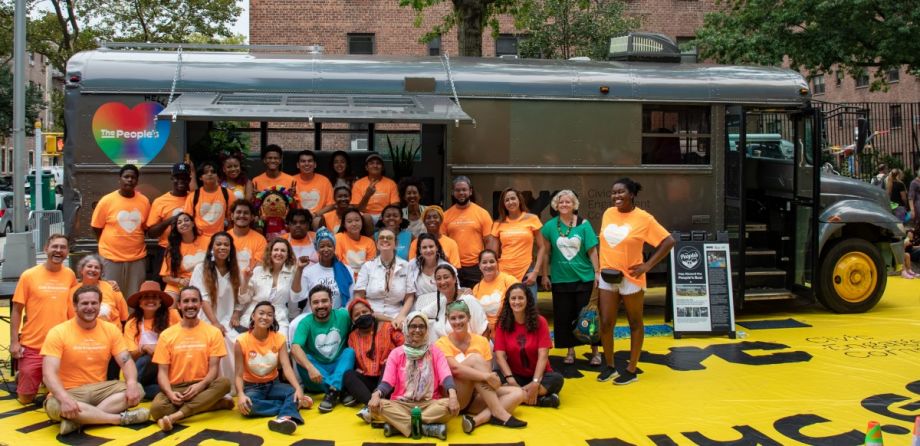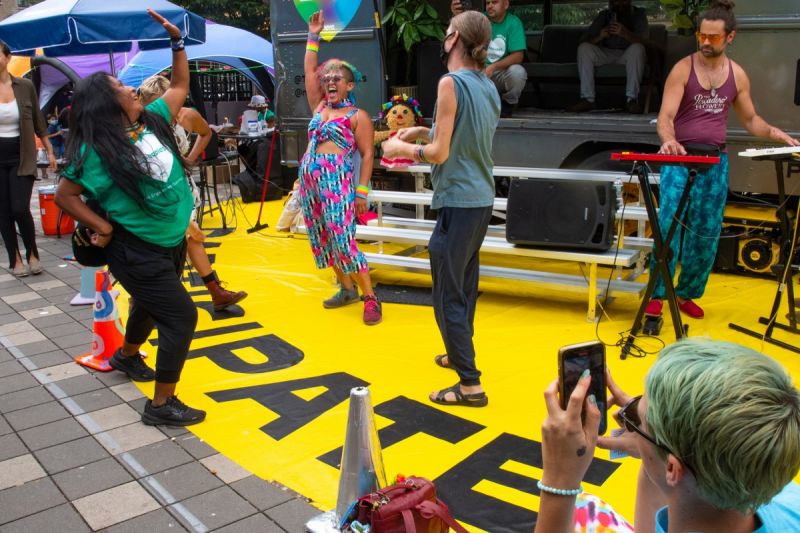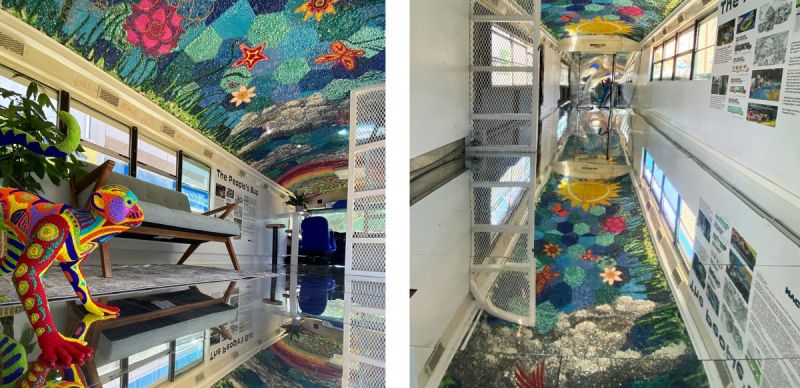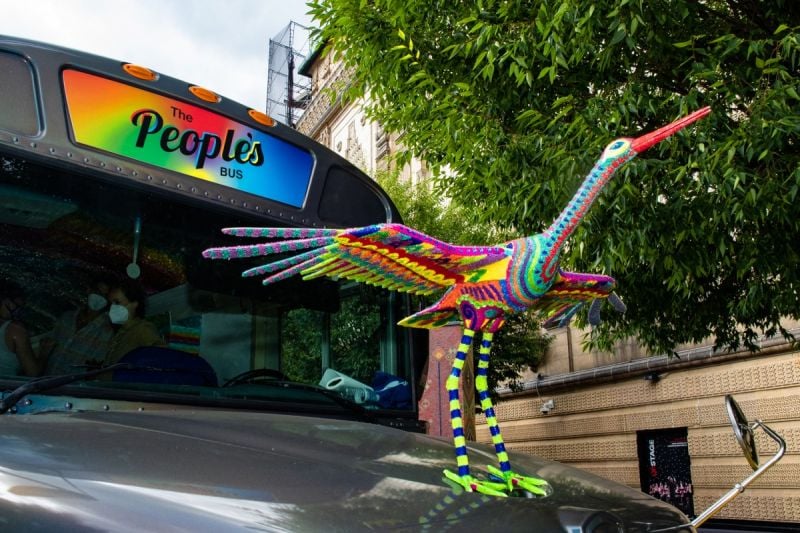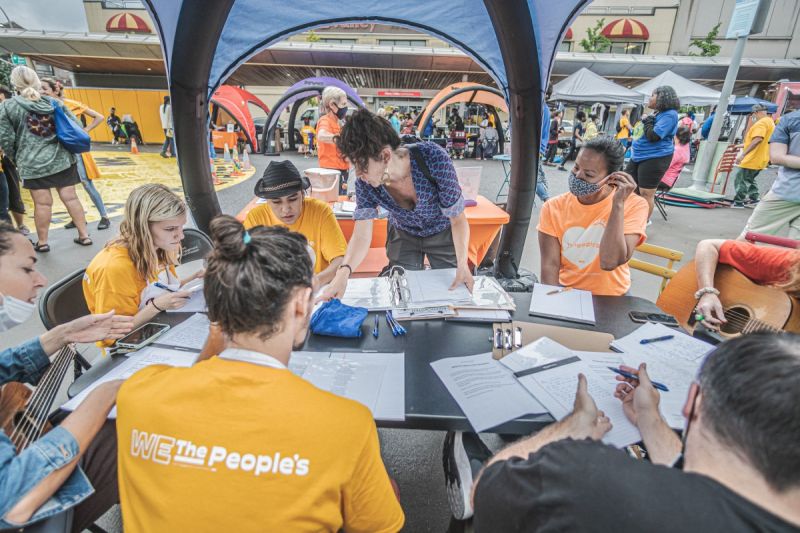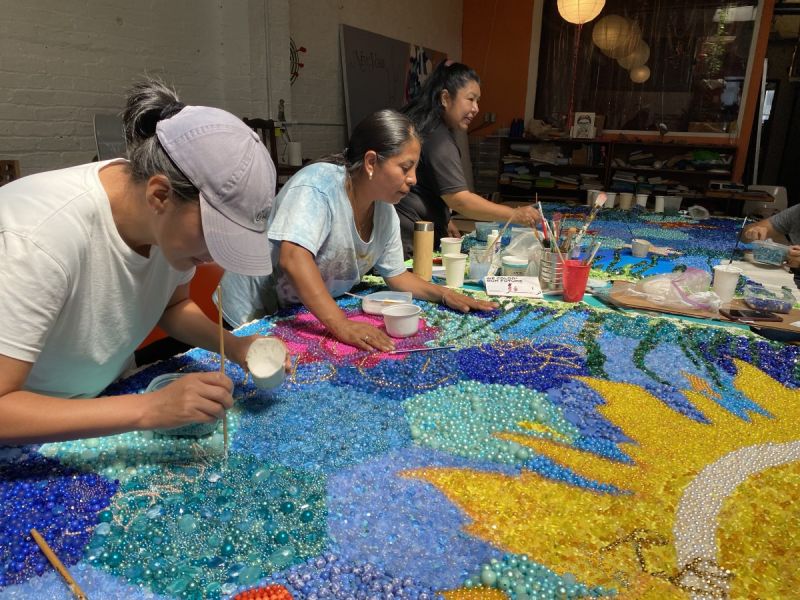In honor of National Voter Registration Day this September, a transformed city bus — formerly used to transport people detained on Rikers Island — rolled into Flatbush, Brooklyn. Once parked, it became the site of both civic engagement and celebration, with live music, dance and spoken word performance alongside voter registration outreach. Inside the bus, residents could sit and relax on a blue couch, peruse the artwork that now decorates the interior, or view an LED map displaying COVID impact in New York’s hardest-hit neighborhoods.
This effort is known as The People’s Bus, an initiative by New York City’s Civic Engagement Commission to engage New Yorkers most harmed by the pandemic in community-centered ways. In just six months, the team transformed the bus into a mobile community center, then partnered with community organizations across the city to host events like the one for Voter Registration Day.
“It’s rare for these communities to have a celebratory space created by city government,” says Sarah Sayeed, chair and executive director of the Civic Engagement Commission. “By creating a mobile civic engagement unit, we could meet communities where they’re at, introduce them to our work, other partners we work with, and just celebrate the resiliency of New Yorkers at this time.”
The history of the Civic Engagement Commission only dates to November 2018, when New York City voters approved a ballot initiative forming a commission focused on engagement issues, including participatory budgeting, poll site language assistance and community board support and training. By 2020, in the midst of the pandemic, “we were struggling with how we should let people know we exist,” says Sayeed.
“This is the only agency that has a mandate to build trust in our democracy,” says Yazmany Arboleda, who joined the commission for a one-year artist-in-residency through the city’s Public Artist in Residence program. “I began thinking about how I could tell the story of what we’re doing in a way that’s beautiful and inviting and cool and human.”
Arboleda wanted to create a celebratory, healing and educational space that responded to the traumas of the pandemic, which most harmed New York’s lower-income neighborhoods: “What I landed on was that it should happen on a bus, a mobile unit we can pilot and see how we can meet people where they are in this moment.”
Arboleda partnered with Zarith Pineda, founder of the nonprofit design collective Territorial Empathy, to ensure the design and planning process would be as inclusive as possible. Pineda — who has worked with the youth-led organization IntegrateNYC — collaborated with young people, dubbed “People’s Fellows,” to participate as part of a three-month paid internship. Pineda’s previous project, Segregation Is Killing Us, outlined the impact of COVID-19 in historically segregated communities; that project informed the neighborhoods the bus would travel to.
In some cases Arboleda and Pineda struggled to navigate city bureaucracy and red tape to accomplish the type of grassroots engagement they had envisioned. It took over three months, eight city agencies, and a team of lawyers just to secure the vehicle. The commission had limited city funding, so Arboleda fundraised private dollars and Territorial Empathy did some work pro-bono.
In June, the bus embarked on a five-borough listening tour to figure out what New Yorkers wanted from it. “We wanted to know how a space that had caged us could now serve us,” as People’s Fellow Eden Rolle put it. The team distributed over 800 ballots in the form of ranked-choice voting — which was implemented in New York City this year — and found New Yorkers most wanted a “People’s Stage” and “People’s Art Studio.”
The commission transformed the bus in collaboration with Mujeres En Movimiento to create a mural on its ceiling with 8.8 million beads. (Existing graffiti was traced with gold beads, to acknowledge the bus’s past on Rikers Island.) “We wanted the space to suspend belief and almost transport you to a different place,” Pineda says. They removed most of the bus seating, built a custom hatchback door to turn it into a stage, added solar panels and installed a six-foot-tall LED map of New York showing research from Segregation Is Killing Us, constructed by the Illuminate Cities project.
“We really used that as a pedagogy tool to talk to New Yorkers about inequities in the city,” Pineda explains of the map. “Not only did we show the COVID rates, we followed up with vaccination rates and showed the community’s access to green space.”
Those conversations happened during the People’s Festival, in which the commission partnered with six groups on the city’s Taskforce on Racial Inclusion and Equity Neighborhood Coalition and 16 government offices. 148 artists were hired with New York City Artists Corps recovery funding, including DJs, choirs, dancers and photographers.
Nearly 100 attendees participated in the People’s Festival on Staten Island, where the Ice Cream Truck of Rights (a different vehicle) distributed free ice cream and cards with housing, healthcare, educational and immigrant resources, and a member of Mujeres en Movimiento led festivalgoers in dance. Tents with representatives from local organizations and city agencies lined a nearby street, including DemocracyNYC, the NYC Commission on Human Rights, Partnership for Parks and the Staten Island Chamber of Commerce.
At another event, the city’s Environmental Justice Advisory Board sought feedback on its accountability framework alongside Drag Queen Story Hour. In Brooklyn this month, DemocracyNYC, local community organizations and artists spread word of the voter registration deadline and the commission’s Poll Site Language Assistance Program while a DJ played.
“It proves that the people most subjected to decisions of people in power — youth, immigrant communities, BIPOC individuals — we are closest to the solutions and yearning for space to be in collaboration with each other,” Rolle says of the festival.
For Sayeed, this pilot shows the ways the commission can forge new paths for civic engagement. “Because the commission is a new entity, it allowed us to infuse the arts in a more impactful way, because we could integrate it into our infrastructure at a much earlier stage,” she notes. “The power of arts and culture, connecting those two to civic engagement, is a place of real transformation for how we think of civic engagement generally.”
Arboleda hopes this pilot can be a starting point for the “People’s Studio,” a space to further test the engagement tools the team tested over the past six months, and that the People’s Bus will continue to host engagement events through New York City. “What drives the bus?” he asks. “It was important we were bringing resources to these communities while we also prioritized beauty and joy.”
Gallery: The People’s Bus
This article is part of “For Whom, By Whom,” a series of articles about how creative placemaking can expand opportunities for low-income people living in disinvested communities. This series is generously underwritten by the Kresge Foundation.

Emily Nonko is a social justice and solutions-oriented reporter based in Brooklyn, New York. She covers a range of topics for Next City, including arts and culture, housing, movement building and transit.
Follow Emily .(JavaScript must be enabled to view this email address)

